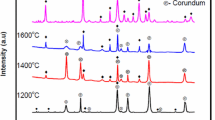Conclusions
The effect of the type of mullite on the sintering process of mullite-zircon specimens was studied. It was shown that using electromelted mullite as chamotte ensures optimum properties. Sintered mullite increases the porosity of the products.
The optimum content of the argillaceous binder for obtaining dense and strong specimens was found to be 10%.
It was shown that highly refractory oxides intensify (activate) the sintering process of the mullite-zircon products obtained using electromelted mullite and strengthen them to the maximum extent. In this case, their thermal shock resistance remains quite high.
The salts of REE have a positive effect on the sintering process of the mullite-zircon specimens at 1650°C and improve their strength; however, in this case, their thermal shock resistance decreases abruptly. The oxides of REE lead to less intense sintering of the mullite-zircon specimens but these additives increase their strength significantly and impart the required thermal shock resistance.
The sintering process of the mullite-zircon specimens occurs in the presence of a liquid phase and is accomplished in three stages whose kinetics can be described by the relationships (proportionalities)Δl/l∼τ1,3, Δl/l∼τ1/2, and Δl/l∼τ1/3, respectively.
Similar content being viewed by others
Literature cited
P. P. Budnikov and A. A. Litvakovskii, Dokl. Akad. Nauk SSSR,106, No. 2, 267–270 (1956).
H. Fewler, Nature,178, No. 3, 158–159 (1956).
M. Bartuska, Sillikattechnik,26, No. 6, 186–187 (1975).
J. Routschka, Glas-Email-Keramo-Technik,21, No. 9, 325–332 (1970).
I. G. Orlova and A. I. Gudilina, Ogneupory, No. 3, 40–45 (1979).
I. G. Orlova, A. I. Gudilina, E. I. Aksel'rod et al., ibid., No. 1, 56–60 (1980).
I. S. Kainarskii, I. G. Orlova, and A. I. Natsenko, ibid., No. 2, 31–37 (1972).
W. Baumgart, Ber. Dtsch. Keram. Ges.,50, No. 7, 237–240 (1973).
I. S. Kainarskii, I. G. Orlova, and E. V. Merkulova, Byull. Nauch. Tekhn. Inform. UkrNIIO, Kharkov, Metallurgizdat, Issue 4, 5–23 (1958).
N. N. Kruglitskii, Principles of Physicochemical Mechanics [in Russian], Part 1, Vishcha Shkola, Kiev (1975).
A. I. Portnova, I. L. Boyarina, and É. V. Degtyareva, Ogneupory, No. 5, 43–47 (1979).
L. V. Miroshnik, I. L. Boyarina, Z. I. Lobko, et al., ibid., No. 6, 8–11 (1983).
É. V. Degtyareva, O. T. Gud', E. D. Lisovaya, et al., ibid., No. 2, 10–13 (1987).
W. D. Kingery, J. Appl. Phys.,30, 301–304 (1959).
I. S. Kainarskii, Processes of Refractories Technology [in Russian], Metallurgiya, Moscow (1969).
Author information
Authors and Affiliations
Additional information
Translated from Ogneupory, No. 8, pp. 12–17, August, 1988.
Rights and permissions
About this article
Cite this article
Degtyareva, É.V., Romaniv, O.N., Gud', O.T. et al. Effect of the type of mullite and certain additives on the sintering process of mullite-zircon specimens. Refractories 29, 457–462 (1988). https://doi.org/10.1007/BF01297639
Issue Date:
DOI: https://doi.org/10.1007/BF01297639




